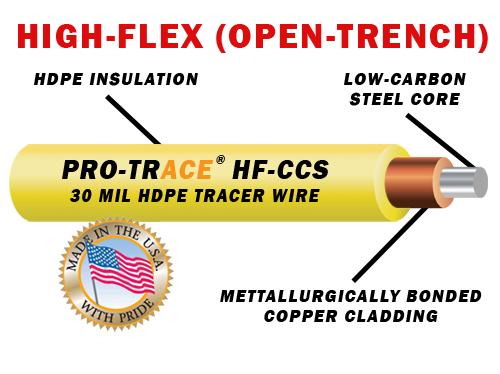The difference between tracer wire, TW/THW, and THHN Wire?
What is the difference between underground tracer wire, TW/THW electrical wire tracer, and THHN building wire? Moreover, can THHN wire be used as locating wire?
In the market for underground tracer wire?
What is underground tracer wire?
 Underground tracer wire is also known as locating wire or electrical wire tracer. This wire is buried alongside underground plastic pipes, fiber optics, or undetectable lines so that locating equipment can detect the locating wire, hence the utility line, before digging.
Underground tracer wire is also known as locating wire or electrical wire tracer. This wire is buried alongside underground plastic pipes, fiber optics, or undetectable lines so that locating equipment can detect the locating wire, hence the utility line, before digging.
The wire is coated with 30 to 45 millimeters of polyethylene (plastic), making it durable, resilient, and well-insulated to sustain adverse weather conditions and be resistant to liquids, chemicals, and corrosion, and be flexible.
What is TW/THW?
TW or THW means thermoplastic high heat-resistant and water-resistant. Typical uses of TW/THW electrical wire tracer are in control panels, air conditioning equipment, refrigeration equipment, control wiring of machine tools, and automatic washers. This tracer wire is used in industrial, commercial, and residential applications where it is dry and less than 194 F.
What is THHN Wire?
THHN wire or thermoplastic high heat-resistant nylon wire is a favorite building wire used to transmit electricity through buildings. The wire itself may be aluminum or copper, but it is not tracer wire. THHN satisfies most residential and industrial electrical needs and has approval for up to 600 volts and 194 °F. THHN is less expensive than tracer wire.
Can I use THHN as an underground locating wire?
While gas, water, fiber-optic, and sanitation companies use underground tracer wire, from time to time, contractors and subcontractors mistakingly use THHN, which can be problematic.
THHN is not insulated sufficiently to hold up over the underground utility’s lifespan, which may last 30 years. The primary coating of THHN is nylon, which is vulnerable to moisture and will eventually break down, and the wire will erode, becoming unusable. If THHN is used as tracer wire, when it fails, the line will need to be excavated, and the THHN wire will require replacement. While THHN wire is less expensive than tracer wire, the small increase in price is insignificant compared to the tremendous cost associated with excavating a line to replace the tracer wire.
Proline
Linc Energy Systems is a master distributor of Proline tracer wire. If you are interested in underground tracer wire, we are here to assist you.



nice article.